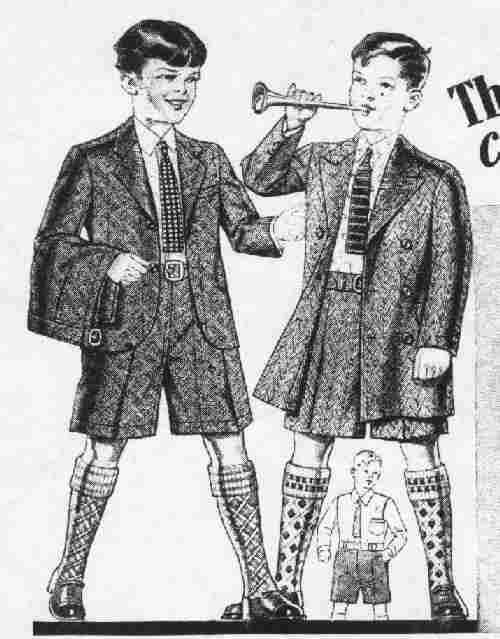
U.S. Short Pants Suits: 1929

Figure 1.--Sears in 1929 offered short pants suits for boys from 3 to 9 years of age. Suits like these were often referred to as English-style suits. Many came with two pairs of shorts. They were mostly worn with kneesocks. Click on the image for a view of other boys' garments being sold in 1929. Note the boy on the right wears a coat and not a suit jacket.
|
Generaly younger boys wore short pants suits in 1929. They were mostly single breasted, although double breasted suits were available. Most were patterened rather than solid color suit. Betters suits were wool or wool blends and lined. Colors included brown, blue, and grey. Sizes varied from store to store. They were generally available for boys up to about 10 at mass retailers. Better mens' outfitters cattering to affluent clientile might have them in larger styles. They were still mostly worn with kneesocks.
Sears
These two suits were offered for sale by Sears in 1929. Here is what Sears had to say about these two suits
All wool and silk
A medium brown all wool and silk cassimere in a neat diamond weave with Rayon decorations. Coat is a two button model with notched lapels. Lined with fancy durable lining. English shorts style pants are full lined. and have self belt with buckle. Sizes--4 to 9 years. State age size.
Brown all wool and silk Cassimere suit with extra pants. Postpade $5.45. Suit as above with only one pair of shorts. Post paid $3.95.
HBC comments: Note the one boy's center hair part. Also note the tie with a horizontal cut end. The shorts at left have a cuffed looked. Also notice the patterned kneesocks with a varied pattern at the sock cuff.
Ensemble suit
A very attractive suit consisting of English short style pants which buttoned to a figured madras waist. [HBC note: waist means shirt.] Harmonizing mercerized tie. The full lined pants have self belt with buckle. Coat listed separately. Sizes--3 to 8 years. State age size
Suit consisting of blusish grey, all wool and silkcassimere pants with rayon decorations, figured waist and tie. Postpaid $1.79. Reefer coat to match suit above. Fully lined. Sizes 3 to 8 years. State age size. Postpaid $3.50.
HBC comments: The boy on the right wears a coat and not a suit jacket, note the longer length and different lapel cut. Also note the horizontal stripes and end of the tie. Also note the patterened kneesocks.
Short pant were worn by younger boys from about 3 to 9 or
10 years of age. Knickers were also available for this age
group, but long pants were still not very common. Shorts
were mostly worn with kneesocks although some boys still
wore long stockingsespecially during the winter. Some boys a
few years older might wear them in the South. They were
also more common for boys from affluent families. Better
mens' outfitters might have shorts for slightly older boys then
the mass market stores. Shorts were also more commonly worn in European ethnic communities. Many American boys didn't like thenm and would have much preferred to wear
knickers or long pants.
The mass retailers in 1929 offered both short pants and knicker suits for younger boys. The knicker suits for younger boys were in sizes from 4/5 to 9/10 years of age. Older boys
wore either knickers or long pants. Patterned suits were still the most common. They were increasingly being worn with kneesocks, but some boys still wore knickers with long
stockings. Most retailers and manufacurers separated suits for younger and older boys. The dividung line for these suits was about 10 years of age.
Additional Information
New style: 1920s
The Party: 1950s
Traveling in Europe: 1960s
British debate: 1960s
Boyhood memories
Christopher Wagner
histclo@lycosmail.com
Navigate the Boys' Historical Clothing Web Site:
[Return to the Main U.S. 1920s short pants suit page]
[Return to the Main national short pants page suit]
[Introduction]
[Activities]
[Bibliographies]
[Biographies]
[Chronology]
[Clothing styles]
[Contributions]
[FAQs]
[Photo]
[Boys' Clothing Home]
Created: March 14, 2000
Last updated: March 15, 2000


